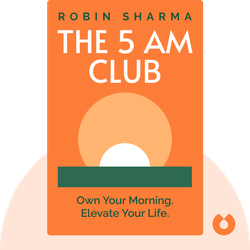Try Blinkist to get the key ideas from 7,000+ bestselling nonfiction titles and podcasts. Listen or read in just 15 minutes.
Start your free trial
Blink 3 of 8 - The 5 AM Club
by Robin Sharma

Discover the Foods Scientifically Proven to Prevent and Reverse Disease
How Not to Die by Michael Greger and Gene Stone is a comprehensive guide to using nutrition as a form of preventative medicine. Drawing on scientific research, the book provides practical advice for optimizing health and avoiding chronic diseases.
Today many people live to 100 and beyond, but living longer doesn’t mean living healthier.
According to a study published in the American Journal of Medicine of 42,000 autopsies of patients aged over 100, a large percentage died from diseases rather than simply old age, despite being assessed as healthy right up until their deaths.
How come?
The primary culprit is diet. Just take a “Nutritional Update for Physicians” published in the Permanente Journal in 2013, which said that the meat, dairy, eggs and processed foods that dominate the typical American diet are bad news. The study found that people who ate diets rich in these food groups were at greater risk of heart disease, diabetes and a number of other chronic ailments. Not just that, but excessive animal fat and processed meat also resulted in high cholesterol and an elevated chance of heart disease.
If you don’t accept that, just compare the American diet to that of another nation. After adopting US eating habits, Japanese-Americans are at as great a risk of suffering a heart attack at 40 as their Japanese counterparts are at 60.
So, food is the issue, and the American medical profession is sorely lacking in nutritional knowledge. It’s so bad that only 25 percent of all US medical schools offer even one course in nutrition, marking a 37 percent decline from just 30 years ago.
This is no accident. In 2001, a bill was introduced in California that would require physicians to receive 12 hours of nutritional training over four years, but the California Medical Association opposed it. The California Medical Board requires all doctors to receive 12 hours of training in pain management and end-of-life care but has less interest in using nutrition to stop people getting sick.
Instead, doctors are being taught to prescribe drugs. As a result, the US market is responsible for one-third of the $1 trillion plus spent annually on prescriptions worldwide, and around 70 percent of Americans take a prescription drug regularly.



How Not to Die (2015) explains how a plant-based diet can extend your life while transforming your quality of living. These blinks offer a wealth of health-boosting nutritional information and hands-on dietary advice that you won’t get from your doctor.
How Not to Die (2015) is a valuable resource that explores the science behind preventing and reversing chronic diseases through nutrition. Here's why this book is worth reading:
The study of the teeth of ancient civilizations, where no toothbrush or floss was ever used, found almost no cavities. Candy bars hadnt been invented yet.

It's highly addictive to get core insights on personally relevant topics without repetition or triviality. Added to that the apps ability to suggest kindred interests opens up a foundation of knowledge.
Great app. Good selection of book summaries you can read or listen to while commuting. Instead of scrolling through your social media news feed, this is a much better way to spend your spare time in my opinion.
Life changing. The concept of being able to grasp a book's main point in such a short time truly opens multiple opportunities to grow every area of your life at a faster rate.
Great app. Addicting. Perfect for wait times, morning coffee, evening before bed. Extremely well written, thorough, easy to use.
Try Blinkist to get the key ideas from 7,000+ bestselling nonfiction titles and podcasts. Listen or read in just 15 minutes.
Start your free trial
Blink 3 of 8 - The 5 AM Club
by Robin Sharma
What is the main message of How Not to Die?
The main message of How Not to Die is that a healthy diet can prevent and reverse many chronic diseases.
How long does it take to read How Not to Die?
The reading time for How Not to Die varies depending on the reader's speed, but it typically takes several hours. However, the Blinkist summary can be read in just 15 minutes.
Is How Not to Die a good book? Is it worth reading?
How Not to Die is worth reading as it provides evidence-based advice on preventing disease and improving health.
Who is the author of How Not to Die?
The author of How Not to Die is Michael Greger and Gene Stone.